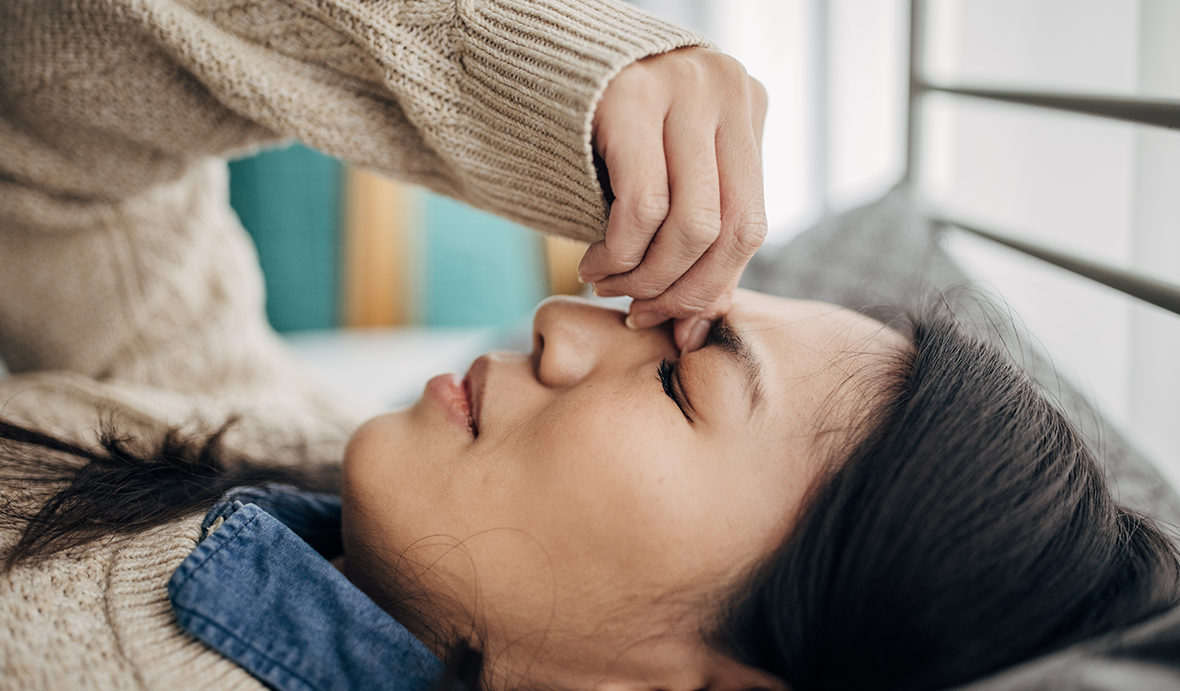Intense headaches, nausea, blurred vision... Ophthalmic migraines—sometimes called migraines with aura—can be accompanied by a range of symptoms. What causes them? How can they be prevented and treated? Let’s take a closer look.

What does an ophthalmic migraine feel like? Martine’s experience
Like all of us, Martine, 43, has experienced the odd headache brought on by stress, fatigue, or one too many drinks. But nothing could have prepared her for her first ophthalmic migraine.
All of a sudden, the left side of my head started pounding. It felt like a jackhammer was boring into my skull. I started seeing black spots in my left field of vision, and everything went blurry. Within 15 minutes, I could no longer see out of my left eye, and I was sweating and nauseous. I panicked!
What is an ophthalmic migraine?
An ophthalmic migraine often starts with vision problems, also called aura. Most of the time, these troubles come with a headache.
It is important to make the difference between a regular headache and a migraine.
- Headaches (or cephalgia) tend to be short-lived and can be treated effectively with pain relievers.
- Migraines, which affect roughly 20% of adults, are usually characterized by severe head pain. They can last up to 72 hours and may be accompanied by nausea, vomiting, and hypersensitivity to light, sounds, or smells.
Ophthalmic migraines have a number of other possible symptoms:
- Black spots or flashing zigzag lines (auras) that appear before or during headaches
- Temporary loss of sight (partial or total)
- Weakening of the muscles on one side of the body
- Tingling in the hands, face, or tongue
- Trouble speaking
Not all of these symptoms are common, and they vary significantly from one person to the next. In addition, visual auras can occur without an associated headache.
What causes ophthalmic migraines?
Migraines, including migraines with visual aura, are caused by a dilation or inflammation of arteries in the head. It’s hard to pinpoint why some people are more prone to migraines than others. Likely causes include genetics and hormonal changes (during pregnancy or the menstrual cycle, for example).
We also know that ophthalmic migraines can be triggered by factors such as the following:
- Stress and strong emotions
- Lack of sleep
- Alcohol or tobacco use and certain foods
- Loud noises and strong smells (perfume, cigarette smoke, chemicals, etc.)
- Extreme temperatures and variations in atmospheric pressure
How can migraines with visual aura be prevented?
As with all types of migraines, preventing ophthalmic migraines starts with adopting good lifestyle habits. This includes:
- Staying hydrated and maintaining a balanced diet
- Practising relaxation and stress management techniques
- Avoiding sensory overload (e.g., noises, smells)
- Exercising
- Adopting good sleep hygiene and not overexerting yourself
- Reducing your alcohol consumption
- Quitting smoking and avoiding secondhand smoke
How are ophthalmic migraines treated?
If you experience a migraine attack, there are several ways to relieve or lessen the symptoms:
- Isolate yourself in a dark, quiet space
- Apply cold-water compresses to your forehead and face
- Gently massage your temples
- Take anti-inflammatory drugs
Your pharmacist can also be a valuable resource if you suffer from migraines with visual aura. In addition to offering advice on what to do during an episode, they can:
- Ensure that the recommended treatment does not interact with other medications, including over-the-counter and natural health products
- Adjust your migraine medication if you already have one
- Offer to conduct more regular follow-ups in the case of frequent migraines
- Refer you to another health care professional to be evaluated and, if necessary, prescribed a preventive medication
Regardless, don’t hesitate to consult your pharmacist for more information on the different types of migraines, including ophthalmic migraines, and how to prevent and treat them.
Learn more about migraines
Listen to this episode of the French-language podcast MaSanté sans tabous to hear Jean-Nicolas Verreault and guest Myriam Tremblay, a Brunet-affiliated pharmacist-owner, answer the most common questions about migraines and migraine treatment.

Renew and pay wherever you want, whenever you want
Keep your health at your fingertips: manage your prescriptions and those of your loved ones with the Brunet MaSanté app. Discover it here!
